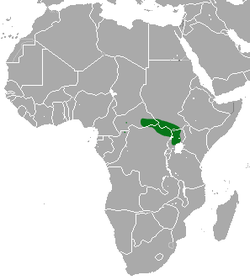| Pousargues's mongoose | |
|---|---|
 | |
| Wild Pousargues's mongoose in the Chinko Project Area | |
| Scientific classification | |
| Kingdom: | Animalia |
| Phylum: | Chordata |
| Class: | Mammalia |
| Order: | Carnivora |
| Family: | Herpestidae |
| Genus: | Dologale Thomas, 1920 |
| Species: | D. dybowskii |
| Binomial name | |
| Dologale dybowskii Pousargues, 1893 | |
 | |
| Pousargues's mongoose range | |
Pousargues's mongoose (Dologale dybowskii), also known as the African tropical savannah mongoose, is a mongoose native to Central Africa. It is listed as data deficient on the IUCN Red List as little is known about its distribution and ecology. [1] It is the only species in the genus Dologale. [2]
Contents
Up to the late 20th century, it was known from only around 30 zoological specimens in natural history museum collections. [2]

